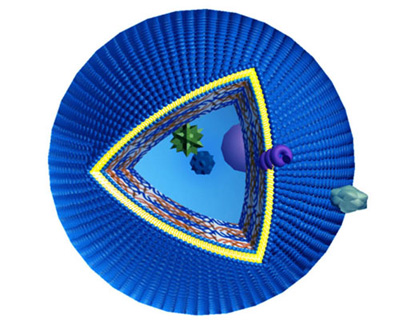Progress on Molecular Assembly of Multifunctional Biomimetic Microcapsules
With the recent developments of molecular and nanoscale engineering in physical sciences, and advances in molecular biology, biomimetic is now entering the molecular scale. Biomimetic on the molecular level, i.e. molecular biomimetic, refers to human-made processes, devices, or systems that mimic or imitate certain aspects of biological systems. Molecular biomimetic is not limited to just copying nature because, with the development of modern biology, scientists can directly utilize biological units themselves to construct hybrid nanostructured materials. Thus, some of the manufacturing difficulties of biomimetics can be avoided. Under the supports of Chinese Academy of Science and National Natural Science Foundation Prof. Junbai Li’s group from the CAS Key Laboratory of Colloid Interface Science and Chemical Thermodynamics made progress in the molecular assembly of biomimetic system. This group is recently invited to contribute a review article in Chem. Soc. Rev. (2009, 38, 2292-2303) entitled as “Molecular assembly of biomimetic microcapsule”. This review article covered the most recent research work in the field of biomimetic microcapsules based on molecular assembly technique.
Based on principles from living cells, Prof. Li’s group has developed a new type of biomimetic membrane system --- lipid-bilayer modified polymer or protein multilayer microcapsules. In contrast with the conventional liposomes, these biomimetic systems could better mimic a variety of biological functions of living cells by using “self-assembly” and “layer-by-layer assembly” techniques and provide new biomembrane model for biophysical and chemical researches(Angew. Chem. Int. Ed. 40 (2001) 891; Chem. Eur. J. 9 (2003) 2589; Soft Matter 1 (2005) 259; Biomacromolecules 7 (2005) 580). Furthermore, the structure and function of these biomimetic systems can be tuned well on the molecular level and thus many biological functions of cell membranes can be recreated. These assembled systems have potential in the field of targeted drug delivery and controlled release (Chem. Eur. J. 10 (2004) 5848;Biomaterials 28 (2007) 3083;Angew. Chem. Int. Ed. 46 (2007) 2431;J. Mater. Chem. 17 (2007) 4018;Biomaterials 30 (2009) 2799). On the other hand, these cell-mimic structures can also be used to engineer bionanodevices. For instance, the reconstitution of chloroplastic ATPase within lipid bilayer-coated polyelectrolyte or protein multilayer microcapsules indicates that molecular motor activity was maintained well in these man-made systems (Angew. Chem. Int. Ed. 46 (2007)6996;Adv. Mater. 20 (2008) 601;Adv. Mater. 20 (2008) 2933;J. Phys. Chem. B 113 (2009) 395). Such biomimetic systems may potentially be useful for constructing novel bionanodevices in the future.
Chem. Soc. Rev. , 2009, 38, 2292-2303

A new type of biomimetic membrane structure - lipid-bilayer modified polymer multilayer microcapsules.





